Kun Zhu
EEG-FM-Bench: A Comprehensive Benchmark for the Systematic Evaluation of EEG Foundation Models
Aug 25, 2025Abstract:Electroencephalography (EEG) foundation models are poised to significantly advance brain signal analysis by learning robust representations from large-scale, unlabeled datasets. However, their rapid proliferation has outpaced the development of standardized evaluation benchmarks, which complicates direct model comparisons and hinders systematic scientific progress. This fragmentation fosters scientific inefficiency and obscures genuine architectural advancements. To address this critical gap, we introduce EEG-FM-Bench, the first comprehensive benchmark for the systematic and standardized evaluation of EEG foundation models (EEG-FMs). Our contributions are threefold: (1) we curate a diverse suite of downstream tasks and datasets from canonical EEG paradigms, implementing standardized processing and evaluation protocols within a unified open-source framework; (2) we benchmark prominent state-of-the-art foundation models to establish comprehensive baseline results for a clear comparison of the current landscape; (3) we perform qualitative analyses of the learned representations to provide insights into model behavior and inform future architectural design. Through extensive experiments, we find that fine-grained spatio-temporal feature interaction, multitask unified training and neuropsychological priors would contribute to enhancing model performance and generalization capabilities. By offering a unified platform for fair comparison and reproducible research, EEG-FM-Bench seeks to catalyze progress and guide the community toward the development of more robust and generalizable EEG-FMs. Code is released at https://github.com/xw1216/EEG-FM-Bench.
Length Controlled Generation for Black-box LLMs
Dec 19, 2024



Abstract:Large language models (LLMs) have demonstrated impressive instruction following capabilities, while still struggling to accurately manage the length of the generated text, which is a fundamental requirement in many real-world applications. Existing length control methods involve fine-tuning the parameters of LLMs, which is inefficient and suboptimal for practical use. In this paper, we propose a novel iterative sampling framework for text length control, integrating the Metropolis-Hastings algorithm with an importance sampling acceleration strategy. This framework efficiently and reliably regulates LLMs to generate length-constrained text without modifying the underlying parameters, thereby preserving the original capabilities of LLMs. Experimental results demonstrate that our framework achieves almost 100\% success rates of length control on Llama3.1 for tasks such as length-controlled abstractive summarization and length-constrained instruction following, with minimal additional computational overhead. This also highlights the significant potential of our method for precise length control across a broader range of applications, without compromising the versatility of LLMs.
A Semantic Communication System for Real-time 3D Reconstruction Tasks
Dec 02, 2024



Abstract:3D semantic maps have played an increasingly important role in high-precision robot localization and scene understanding. However, real-time construction of semantic maps requires mobile edge devices with extremely high computing power, which are expensive and limit the widespread application of semantic mapping. In order to address this limitation, inspired by cloud-edge collaborative computing and the high transmission efficiency of semantic communication, this paper proposes a method to achieve real-time semantic mapping tasks with limited-resource mobile devices. Specifically, we design an encoding-decoding semantic communication framework for real-time semantic mapping tasks under limited-resource situations. In addition, considering the impact of different channel conditions on communication, this paper designs a module based on the attention mechanism to achieve stable data transmission under various channel conditions. In terms of simulation experiments, based on the TUM dataset, it was verified that the system has an error of less than 0.1% compared to the groundtruth in mapping and localization accuracy and is superior to some novel semantic communication algorithms in real-time performance and channel adaptation. Besides, we implement a prototype system to verify the effectiveness of the proposed framework and designed module in real indoor scenarios. The results show that our system can complete real-time semantic mapping tasks for common indoor objects (chairs, computers, people, etc.) with a limited-resource device, and the mapping update time is less than 1 second.
Discrete Modeling via Boundary Conditional Diffusion Processes
Oct 29, 2024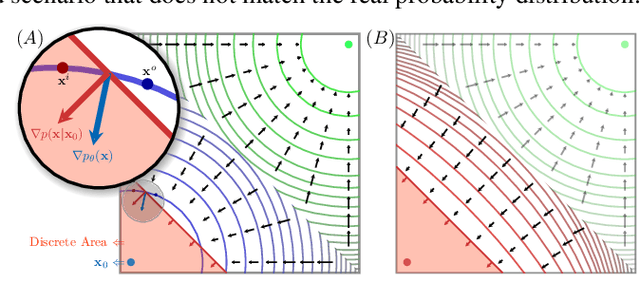


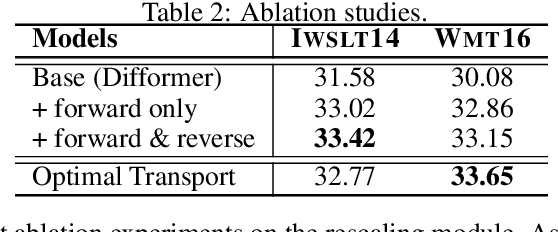
Abstract:We present an novel framework for efficiently and effectively extending the powerful continuous diffusion processes to discrete modeling. Previous approaches have suffered from the discrepancy between discrete data and continuous modeling. Our study reveals that the absence of guidance from discrete boundaries in learning probability contours is one of the main reasons. To address this issue, we propose a two-step forward process that first estimates the boundary as a prior distribution and then rescales the forward trajectory to construct a boundary conditional diffusion model. The reverse process is proportionally adjusted to guarantee that the learned contours yield more precise discrete data. Experimental results indicate that our approach achieves strong performance in both language modeling and discrete image generation tasks. In language modeling, our approach surpasses previous state-of-the-art continuous diffusion language models in three translation tasks and a summarization task, while also demonstrating competitive performance compared to auto-regressive transformers. Moreover, our method achieves comparable results to continuous diffusion models when using discrete ordinal pixels and establishes a new state-of-the-art for categorical image generation on the Cifar-10 dataset.
BFA-YOLO: Balanced multiscale object detection network for multi-view building facade attachments detection
Sep 06, 2024

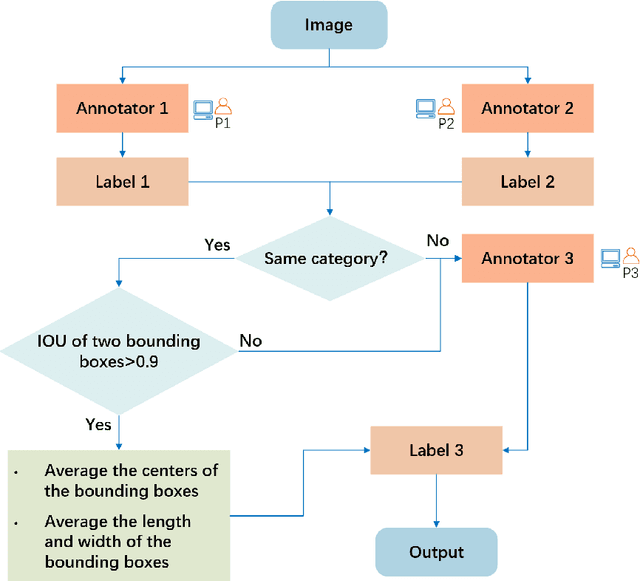

Abstract:Detection of building facade attachments such as doors, windows, balconies, air conditioner units, billboards, and glass curtain walls plays a pivotal role in numerous applications. Building facade attachments detection aids in vbuilding information modeling (BIM) construction and meeting Level of Detail 3 (LOD3) standards. Yet, it faces challenges like uneven object distribution, small object detection difficulty, and background interference. To counter these, we propose BFA-YOLO, a model for detecting facade attachments in multi-view images. BFA-YOLO incorporates three novel innovations: the Feature Balanced Spindle Module (FBSM) for addressing uneven distribution, the Target Dynamic Alignment Task Detection Head (TDATH) aimed at improving small object detection, and the Position Memory Enhanced Self-Attention Mechanism (PMESA) to combat background interference, with each component specifically designed to solve its corresponding challenge. Detection efficacy of deep network models deeply depends on the dataset's characteristics. Existing open source datasets related to building facades are limited by their single perspective, small image pool, and incomplete category coverage. We propose a novel method for building facade attachments detection dataset construction and construct the BFA-3D dataset for facade attachments detection. The BFA-3D dataset features multi-view, accurate labels, diverse categories, and detailed classification. BFA-YOLO surpasses YOLOv8 by 1.8% and 2.9% in mAP@0.5 on the multi-view BFA-3D and street-view Facade-WHU datasets, respectively. These results underscore BFA-YOLO's superior performance in detecting facade attachments.
BeamAggR: Beam Aggregation Reasoning over Multi-source Knowledge for Multi-hop Question Answering
Jun 28, 2024



Abstract:Large language models (LLMs) have demonstrated strong reasoning capabilities. Nevertheless, they still suffer from factual errors when tackling knowledge-intensive tasks. Retrieval-augmented reasoning represents a promising approach. However, significant challenges still persist, including inaccurate and insufficient retrieval for complex questions, as well as difficulty in integrating multi-source knowledge. To address this, we propose Beam Aggregation Reasoning, BeamAggR, a reasoning framework for knowledge-intensive multi-hop QA. BeamAggR explores and prioritizes promising answers at each hop of question. Concretely, we parse the complex questions into trees, which include atom and composite questions, followed by bottom-up reasoning. For atomic questions, the LLM conducts reasoning on multi-source knowledge to get answer candidates. For composite questions, the LLM combines beam candidates, explores multiple reasoning paths through probabilistic aggregation, and prioritizes the most promising trajectory. Extensive experiments on four open-domain multi-hop reasoning datasets show that our method significantly outperforms SOTA methods by 8.5%. Furthermore, our analysis reveals that BeamAggR elicits better knowledge collaboration and answer aggregation.
An Information Bottleneck Perspective for Effective Noise Filtering on Retrieval-Augmented Generation
Jun 03, 2024



Abstract:Retrieval-augmented generation integrates the capabilities of large language models with relevant information retrieved from an extensive corpus, yet encounters challenges when confronted with real-world noisy data. One recent solution is to train a filter module to find relevant content but only achieve suboptimal noise compression. In this paper, we propose to introduce the information bottleneck theory into retrieval-augmented generation. Our approach involves the filtration of noise by simultaneously maximizing the mutual information between compression and ground output, while minimizing the mutual information between compression and retrieved passage. In addition, we derive the formula of information bottleneck to facilitate its application in novel comprehensive evaluations, the selection of supervised fine-tuning data, and the construction of reinforcement learning rewards. Experimental results demonstrate that our approach achieves significant improvements across various question answering datasets, not only in terms of the correctness of answer generation but also in the conciseness with $2.5\%$ compression rate.
Energy-Efficient UAV Swarm Assisted MEC with Dynamic Clustering and Scheduling
Feb 29, 2024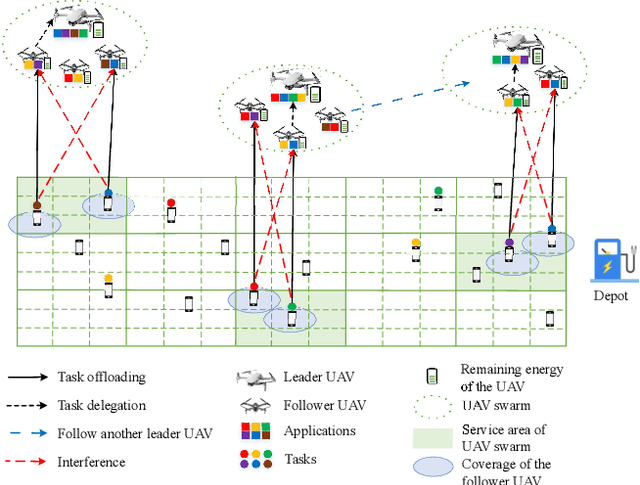

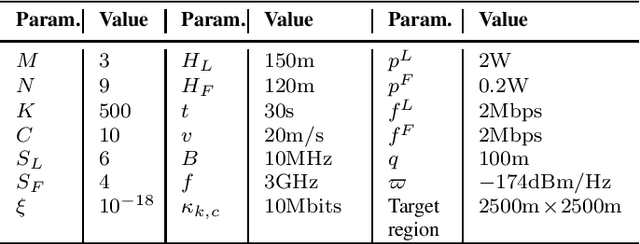
Abstract:In this paper, the energy-efficient unmanned aerial vehicle (UAV) swarm assisted mobile edge computing (MEC) with dynamic clustering and scheduling is studied. In the considered system model, UAVs are divided into multiple swarms, with each swarm consisting of a leader UAV and several follower UAVs to provide computing services to end-users. Unlike existing work, we allow UAVs to dynamically cluster into different swarms, i.e., each follower UAV can change its leader based on the time-varying spatial positions, updated application placement, etc. in a dynamic manner. Meanwhile, UAVs are required to dynamically schedule their energy replenishment, application placement, trajectory planning and task delegation. With the aim of maximizing the long-term energy efficiency of the UAV swarm assisted MEC system, a joint optimization problem of dynamic clustering and scheduling is formulated. Taking into account the underlying cooperation and competition among intelligent UAVs, we further reformulate this optimization problem as a combination of a series of strongly coupled multi-agent stochastic games, and then propose a novel reinforcement learning-based UAV swarm dynamic coordination (RLDC) algorithm for obtaining the equilibrium. Simulations are conducted to evaluate the performance of the RLDC algorithm and demonstrate its superiority over counterparts.
Generative AI for Unmanned Vehicle Swarms: Challenges, Applications and Opportunities
Feb 28, 2024



Abstract:With recent advances in artificial intelligence (AI) and robotics, unmanned vehicle swarms have received great attention from both academia and industry due to their potential to provide services that are difficult and dangerous to perform by humans. However, learning and coordinating movements and actions for a large number of unmanned vehicles in complex and dynamic environments introduce significant challenges to conventional AI methods. Generative AI (GAI), with its capabilities in complex data feature extraction, transformation, and enhancement, offers great potential in solving these challenges of unmanned vehicle swarms. For that, this paper aims to provide a comprehensive survey on applications, challenges, and opportunities of GAI in unmanned vehicle swarms. Specifically, we first present an overview of unmanned vehicles and unmanned vehicle swarms as well as their use cases and existing issues. Then, an in-depth background of various GAI techniques together with their capabilities in enhancing unmanned vehicle swarms are provided. After that, we present a comprehensive review on the applications and challenges of GAI in unmanned vehicle swarms with various insights and discussions. Finally, we highlight open issues of GAI in unmanned vehicle swarms and discuss potential research directions.
Apollo's Oracle: Retrieval-Augmented Reasoning in Multi-Agent Debates
Dec 08, 2023



Abstract:Multi-agent debate systems are designed to derive accurate and consistent conclusions through adversarial interactions among agents. However, these systems often encounter challenges due to cognitive constraints, manifesting as (1) agents' obstinate adherence to incorrect viewpoints and (2) their propensity to abandon correct viewpoints. These issues are primarily responsible for the ineffectiveness of such debates. Addressing the challenge of cognitive constraints, we introduce a novel framework, the Multi-Agent Debate with Retrieval Augmented (MADRA). MADRA incorporates retrieval of prior knowledge into the debate process, effectively breaking cognitive constraints and enhancing the agents' reasoning capabilities. Furthermore, we have developed a self-selection module within this framework, enabling agents to autonomously select pertinent evidence, thereby minimizing the impact of irrelevant or noisy data. We have comprehensively tested and analyzed MADRA across six diverse datasets. The experimental results demonstrate that our approach significantly enhances performance across various tasks, proving the effectiveness of our proposed method.
 Add to Chrome
Add to Chrome Add to Firefox
Add to Firefox Add to Edge
Add to Edge